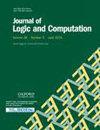Hamilton’s cumular conception of quantifying particles: an exercise in third-order logic
IF 0.7
4区 数学
Q3 COMPUTER SCIENCE, THEORY & METHODS
引用次数: 0
Abstract
Sir William Hamilton is remembered for his proposal to extend the four traditional categoricals to eight by quantifying predicate as well as subject terms. He intended the quantifying particles to be understood in a ‘collective’ or ‘cumular’ manner rather than in a ‘distributive’ or ‘exemplar’ one, but commentators from De Morgan onwards have worked primarily from the latter perspective, comforted in the 20th century by the fact that it translates readily into the language of first-order logic with identity. Formal representation of the cumular approach needs more sophisticated resources, and the paper shows how it may be carried out using selection functions in the language of third-order logic. It also reviews a number of variants, some equivalent and others not so, as well as their reductions to second-order logic, and situates historical sources, both before and after Hamilton, with respect to the web of formal constructions.汉密尔顿量化粒子的积云概念:三阶逻辑的练习
威廉·汉密尔顿爵士被人们铭记,因为他提出通过量化谓语和主词,将传统的四个范畴扩展到八个范畴。他打算用“集体”或“积云”的方式来理解量化粒子,而不是用“分配”或“范例”的方式来理解,但从德摩根开始的评论家主要是从后者的角度来研究的,在20世纪,这一观点很容易转化为具有同一性的一阶逻辑语言。积云方法的形式化表示需要更复杂的资源,本文展示了如何使用三阶逻辑语言中的选择函数来实现积云方法。它还回顾了一些变体,有些是等价的,有些则不是,以及它们对二阶逻辑的还原,并将汉密尔顿之前和之后的历史来源与形式结构的网络联系起来。
本文章由计算机程序翻译,如有差异,请以英文原文为准。
求助全文
约1分钟内获得全文
求助全文
来源期刊

Journal of Logic and Computation
工程技术-计算机:理论方法
CiteScore
1.90
自引率
14.30%
发文量
82
审稿时长
6-12 weeks
期刊介绍:
Logic has found application in virtually all aspects of Information Technology, from software engineering and hardware to programming and artificial intelligence. Indeed, logic, artificial intelligence and theoretical computing are influencing each other to the extent that a new interdisciplinary area of Logic and Computation is emerging.
The Journal of Logic and Computation aims to promote the growth of logic and computing, including, among others, the following areas of interest: Logical Systems, such as classical and non-classical logic, constructive logic, categorical logic, modal logic, type theory, feasible maths.... Logical issues in logic programming, knowledge-based systems and automated reasoning; logical issues in knowledge representation, such as non-monotonic reasoning and systems of knowledge and belief; logics and semantics of programming; specification and verification of programs and systems; applications of logic in hardware and VLSI, natural language, concurrent computation, planning, and databases. The bulk of the content is technical scientific papers, although letters, reviews, and discussions, as well as relevant conference reviews, are included.
 求助内容:
求助内容: 应助结果提醒方式:
应助结果提醒方式:


